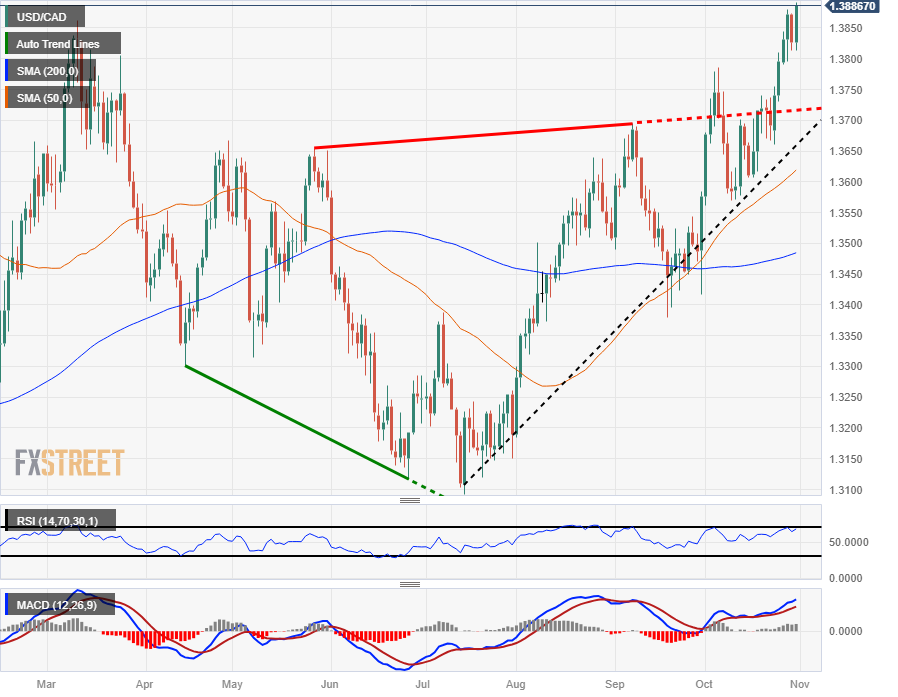Canadian Dollar taps new twelve-month low as markets pivot to Greenback in run up to Fed

- Canadian Dollar falls back as broader markets turn into the US Dollar.
- Canada GDP flattens as economy lags, odds of future rate cuts beginning to rise.
- Fed’s Wednesday rate call has markets twisting, USD is Tuesday’s best performer.
The Canadian Dollar (CAD) has seen a quick end to its almost-rally on Monday, getting pushed back down and tipping into a fresh twelve-and-a-half-month low against the US Dollar (USD).
August’s Canada Gross Domestic Product (GDP) printed flat on Tuesday, missing the forecast of 0.1% and holding flat against July as Canadian economic growth stalls out.
Markets are turning broadly risk-off as investors jump back into the USD ahead of Wednesday’s Federal Reserve (Fed) rate call. While no rate moves are expected from the Fed this week, odds are increasing of one last rate hike in December before 2023 closes out.
Daily Digest Market Movers: Canadian Dollar sees an early failure in recovery rally after market sentiment rug pull
- CAD bulls couldn’t extend Monday’s rebound into a second day as broad market risk appetite evaporates.
- USD is the largest market gainer for Tuesday, Dollar Index (DXY) climbs almost a full percent into 106.80 from Tuesday’s bottom of 105.90.
- Canadian GDP came in flat, missing expectations as Canadian manufacturing sectors chalk in a fifth straight month of growth declines, with notable losses in agriculture due to dry conditions in Western Canada.
- Odds of a rate cut in Q2 next year are rising as the Canadian economy shows deeper cracks.
- Fed’s rate call on Wednesday to be the major market focus mid-week, investors beginning to price in one more 25-basis-point rate hike from the FOMC in December.
- Bank of Canada (BoC) Governor Tiff Macklem will be squeaking in under the radar tomorrow, due to finish out day two of testifying before the Canadian government’s banking and finance oversight committee.
- BoC Governor Macklem day one highlights here.
USD/CAD Technical Analysis: Canadian Dollar can’t find strength to fight off US Dollar
The USD/CAD is heading back toward 1.3900 in Tuesday trading as the US Dollar sees a broad-market resurgence.
The USD/CAD kicked into an intraday low of 1.3813 Tuesday morning before the Greenback came roaring back, sending the USD/CAD into a fresh twelve-and-a-half month high above 1.3880.
The pair is vaulting off the 50-day Simple Moving Average (SMA) lifting into 1.3850, with the 200-day SMA building out a price floor from 1.3770.
Technical resistance to the topside is looking increasingly thin, with the only notable sticking point sitting at 1.3977, 2022’s annual high set back in October of last year.
USD/CAD Daily Chart
Fed FAQs
Monetary policy in the US is shaped by the Federal Reserve (Fed). The Fed has two mandates: to achieve price stability and foster full employment. Its primary tool to achieve these goals is by adjusting interest rates.
When prices are rising too quickly and inflation is above the Fed’s 2% target, it raises interest rates, increasing borrowing costs throughout the economy. This results in a stronger US Dollar (USD) as it makes the US a more attractive place for international investors to park their money.
When inflation falls below 2% or the Unemployment Rate is too high, the Fed may lower interest rates to encourage borrowing, which weighs on the Greenback.
The Federal Reserve (Fed) holds eight policy meetings a year, where the Federal Open Market Committee (FOMC) assesses economic conditions and makes monetary policy decisions.
The FOMC is attended by twelve Fed officials – the seven members of the Board of Governors, the president of the Federal Reserve Bank of New York, and four of the remaining eleven regional Reserve Bank presidents, who serve one-year terms on a rotating basis.
In extreme situations, the Federal Reserve may resort to a policy named Quantitative Easing (QE). QE is the process by which the Fed substantially increases the flow of credit in a stuck financial system.
It is a non-standard policy measure used during crises or when inflation is extremely low. It was the Fed’s weapon of choice during the Great Financial Crisis in 2008. It involves the Fed printing more Dollars and using them to buy high grade bonds from financial institutions. QE usually weakens the US Dollar.
Quantitative tightening (QT) is the reverse process of QE, whereby the Federal Reserve stops buying bonds from financial institutions and does not reinvest the principal from the bonds it holds maturing, to purchase new bonds. It is usually positive for the value of the US Dollar.
